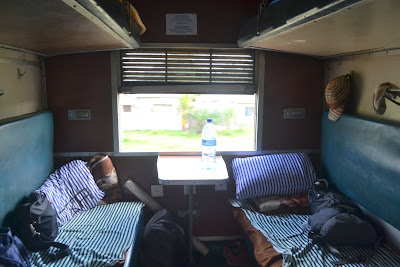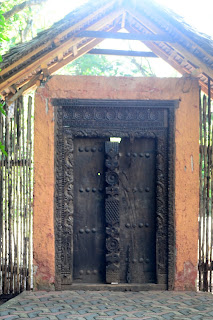It was the weekend before the Independence Day celebration. Since I have always wanted to check out the
Ayala Museum, I decided that it was the best time to pay a visit to the place. What could better than brushing up on Philippine history and marking the day by reflecting on the essence of being a Filipino?
 |
This is a closeup of the diorama depicting Emilio
Aguinaldo's declaration of Independenceat Kawit, Cavite. |
The museum is located at the corner of de la Rosa Street along Makati Avenue. It would have been an easy walk coming from Ayala bus stop, however I had no choice but to take a taxi as the rain started to pour heavily just before I alighted from the bus. From the Ayala bus stop along EDSA, it cost me 60 pesos taxi ride to reach the place. Entrance fee was P225
(local resident rate).
At the onset, I found the museum unwelcoming. There was no warmth from the people at the reception/ admission center. No smiles at all. They did not offer any information. The lady and the guy behind the counter were like mechanized robots- they just got my payment, gave me my ticket and that's it. No other instructions. No offer of the brochures. (
I took one anyway thinking I could browse it later when I get home. I later discovered I could have toured the place for free being a member of the academe.) No directions. So different from the other museums I've been into where you usually have a smiling curator or a tour guide greet you and give you an introduction of the place and maybe offer to give you a guided tour.
I know, I could have asked but I didn't bother. I just proceeded to the second floor where an impressive visual representation of Philippine history is housed. It was where I found out I could have requested for an audio guide (
For a fee of course- I heard it is 75 pesos or something like that). I would have rented one had it been offered earlier at the admission center but I didn't feel like going down again so I just continued with my tour without it. I'd say the 60 dioramas including the different replicas of boats that plied the Philippine waters, located in that floor are really something. The details are so intricate. I admire the patience of the artist who worked on them. The dioramas made history come alive. I lingered for an hour in the place.
 |
This is just part of the gallery. No need for directions, You just start your tour with the diorama marked #1.
|
 |
| The boats that plied the Philippine seas- They models of the Chinese junk, the Arabian baghla, the lorcha, the galleon and the caravel. |
 |
| This is number 28 diorama featuring an Escolta scene. |
The third floor is more like a gallery. Based from the brochure I got, the exhibits change from time to time. When I visited, it featured the art works of Fernando Zobel and Arturo Luz. I am not really an art connoisseur but I did go through each piece trying to connect the title to the art piece. I have read somewhere that it does not do justice to claim a painting to be beautiful--
for what is beauty? It is always more than that. So, I will go with the safest comment. "The paintings were interesting." I am not just saying that. I find it to be true. I never thought that with lines and a few geometric patterns, you can come up with a human figure carrying a basket, or humans dancing. That is what Arturo Luz does. I hate to admit it but I am not cultured enough. My idea of a painting is a landscape or a portrait. At first glance, my initial thought at the paintings of Luz and Zobel was that I could have easily done that myself. They look so simple. But then, the longer I stood there, the more complex the paintings became as I start seeing how the different lines and geometric patterns merge to form an image. It takes a genius to simplify a thought with just a few strokes of the brush in a canvas.
On the same floor is also the exhibit "Vestments for Worship Wrapped in Identity" which showcases the work of Dom Martin Hizon Gomez. The vestments on display were made from textiles woven by the indigenous tribes following their cultural motifs. Going through the collection, made me appreciate more the uniqueness of the indigenous cultures in the country--each culture had one color and one pattern that stood out. This idea was again validated in the textiles section of the museum found in the fourth floor.
Aside from the textiles section, the fourth floor featured a ceramic collection mostly from China, Vietnam and Thailand. There were like hundreds of ceramics on display here. Each one was unique. Mostly, there were plates, mugs, ewers, jars, vases. However, they all have their own elaborate designs and colors. The displays made me want to visit a ceramic factory and see how they work with the artwork. I once visited Dedza pottery in Malawi, however I did not really get to see how they put their designs. For those who are into ceramics, this repository is worth a visit.
Then there is the gold collection. It features gold jewelry found in different parts of the country most of which are from Mindanao and Mindoro. Interestingly, there was none from the Cordilleras, considering that Benguet is known for its gold mines. It is something I need to research about.
I'd say, my favorite part of the museum is the second floor. To appreciate the third and fourth floor better, I recommend renting an audio guide. What makes each piece of art, ceramic or gold jewelry is the backstory--which I missed during my visit.
Would I visit the place again? Definitely. I really need another visit to soak it all in. Just one time is not enough, that is for sure.
As for my initial impression about the place being unwelcoming, I still had that kind of feeling after I left. I was asking myself "Is it me having a different set of standards? Or, are they really snooty?" Is it a part of the staff being discrete and that they are just giving you the space to browse at your own leisure? I do not know but definitely, a warm smile would have made a big difference.


















































